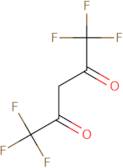1,1,1,5,5,5-Hexafluoro-2,4-pentanedione
CAS: 1522-22-1
Ref. 3D-FH35353
| 2g | Descontinuado | ||
| 5g | Descontinuado | ||
| 10g | Descontinuado | ||
| 25g | Descontinuado | ||
| 50g | Descontinuado |
Informação sobre produto
- Hexafluoroacetylacetone1,1,1,5,5,5-Hexafluoroacetylacetone
- 1,1,1,5,5,5-Hexafluoro-2,4-pentandione
- 1,1,1,5,5,5-Hexafluoroacetylacetone
- 1,1,1,5,5,5-Hexafluoropenta-2,4-dione
- 1,1,1,5,5,5-Hexafluoropentane-2,4-dione
- 1,1,1,5,5,5-Hexafluoropentano-2,4-Diona
- 1,1,1,5,5,5-Hexafluorpentan-2,4-dion
- 1,3-Bis(trifluoromethyl)propane-1,3-dione
- Acetylacetone, 1,1,1,5,5,5-Hexafluoro-
- Hexafluoro-2,4-pentanedione
- Ver mais sinónimos
- Hexafluoroacetylacetonate
- Hexafluoroacetylacetone
- 2,4-Pentanedione, 1,1,1,5,5,5-hexafluoro-
- 1,1,1,3,3,5-hexafluoropentane-2,4-dione
- 1,1,1,5,5,5-hexafluoro-4-hydroxypent-3-en-2-one
- (3E)-1,1,1,5,5,5-hexafluoro-4-hydroxypent-3-en-2-one
1,1,1,5,5,5-Hexafluoro-2,4-pentanedione is a model system for hydrogen fluoride (HF) and its reactions. This molecule has been shown to react with HF in a variety of ways. The reaction solution is colorless due to the formation of an intermediate complex between 1,1,1,5,5,5-hexafluoro-2,4-pentanedione and HF. The reaction mechanism can be explained by the formation of an intramolecular hydrogen bond that allows the H+ ion to attack the carbonyl carbon atom. 1H NMR spectroscopic analysis revealed that this compound reacts with trifluoroacetic acid (TFA) and benzimidazole compounds to form benzimidazoles in good yields. This compound also has photochemical properties and may be used as a ligand for metal ions.





